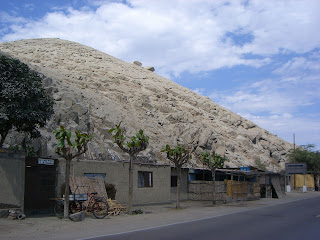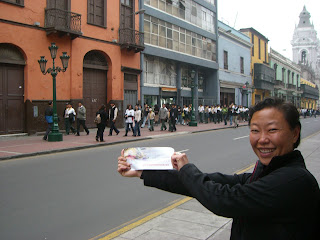Erik: We'd chosen to go to Huancayo, high in the Central Sierra region of Peru, mostly because it was somewhat off the “gringo trail.” Our guide book described it as “a dusty frontier town which slowly grabs at you and endears you to stay.” Not much of a description, but then w

hy not? When I found out that we could take a train ride there, that settled it for me. Too many hours crammed in buses, and ever since having left Europe, I'd missed the peculiar travel experience that is a long train ride. Little did we know, though, that the train took nearly twice as long as the bus, and cost 3-4 times as much! After much thought we decided to splurge and give it a shot anyway, and I'm glad we did. The ride was amazingly scenic, traversing high mountains and deep gorges. At one point the train had to climb a steep hill, and the turn-o

f-the-century engineers had come up with a series of switch backs, in which the train went forwards and backwards up 20 or 30 short strips of zig-zagging track to, in effect, go straight up the hill. Unfortunately sometimes these switchbacks happened in a tunnel, and our car would fill up with black, toxic diesel smoke. Oh well, nothing's perfect. We also got to get off and enjoy the view from the highest train station in the world – both Talor and I were a bit weak, dizzy and nauseous from the thin air there.
The train ride was fun, but we were very happy to finally arrive in Huancayo 13 hours later. We stumbled around the bustling, noisy downtown looking for a hotel – it was Friday night and the sidewalks were packed, and people were in no mood to make way for a couple of backpackers. Finally we found an out-of-the-way hotel, Hostal Plaza, with cheap, comfortable rooms, friendly staff, and the strongest, hottest shower we'd had in nearly our entire trip. What a relief after two long days of nearly non-stop travel.

Huancayo never did manage to pull at our heartstrings, though. It's a big city (400K or so), and very crowded, noisy, dusty and polluted. We took a few day trips out to local points of interest (convents, rock formations, etc.,) but always had to come back to that town of crowded sidewalks, blaring discotheques, and honking cars that would rather plow you over than slow down. To boot, every afternoon at about 2pm the clouds would roll over the surrounding hills, the winds would pick up, and we'd be treated to 2 or 3 hours of downpour. Before we learned the regularity of this atmospheric routine, we'd managed to get drenched and freezing nearly every vday. (Oh, did I mention that Huancayo is very high up and gets quite chilly at night?)
Still, all-in-all, I was happy to have made the trip there, though after a few days, there was very little encouraging me to stay.
Talor: The night before the train ride, we had to spend the night in Lima to board the train at 7am. We left the sun of Casma and arrived into the fog once again, but it was only for one night. Central Lima has a reputation of being very sketchy at night so we were really lucky to find the Hotel Presidente right on the square, just a couple blocks from the train station. Though it was pretty run down, it was a cheap and convenient option for the night. Took a walk to Barrio Chino (Chinatown) and found a restaurant serving curry... yum! Afterwards, grabbed a couple of pork buns and empanadas for our train ride the next day then went to bed.

The ride was very cool, but way too long even with the meal services (breakfast and a hot lunch, like they used to serve on airplanes... but better), and the games of bingo organized by the train staff. It was nice to get off finally, but we were exhausted (it's far more tiring sitting all day than being active) and we had the task of finding a place to lay our head... oy!
Spent the next few days getting to know Hu

ancayo, checking out the different neighborhoods, but as E said, we weren't enamored. And though we had seen a bit of people begging in the streets in Lima, right around the center of Huancayo, there were always a lot asking for money, especially at night. They were obviously very poor, but we don't like giving money so we took to carrying bread and fruit giving whatever we had on hand. Found it a bit depressing. Plus I had a headache the entire time due to the high altitude. My body was not adjusting very well.

But we did manage to find a few bright spots... a Pena (live folkloric music venue) just down the street from our hotel where we drank warm, sweet pisco cocktails and danced with the locals. A visit to the cute little village of Concepcion where we found a very old, very cool monastery used by the missionaries to convert the indigenous but then had been turned into a convent and is now a

museum with ancient art, an amazing library and... curiosity of all curiosities... a room full of taxidermy, animals and fish native to Peru. And for our last evening, we went to a nice quiet restaurant, which is hard to find in Huancayo because all of the restaurants, cafes and fast food joints are always blasting out loud music or televisions. We had a lovely meal of tasty burgers and a salad, managing to avoid the ever-ubiquitous rice and potatoes.
After a good night's sleep, we were ready to blow the dusty town and head to Huancavelica...
Our photos of Huancayo live at...
http://picasaweb.google.com/erikandtalor/HuancayoPeru#
(p.s. We somehow managed to lose a chunk of our photos... the day trips to Concepcion and to Torre Torre. When we find them, we'll put them up.)
 to Cusco – an 11 hour bus ride over some of the bumpiest, most winding dirt road we'd yet experienced. It was impossible to read because of the constant jolts, but we were on a big, comfy bus this time, with reclining seats and even a bathroom aboard, which made up for some of the discomfort. (Though using the facilities during the bumpy, swerving ride was nearly impossible.) Again, the ride was incredibly beautiful, traversing many high mountain passes, and we passed several Inca ruins along the way. By now, though, we'd seen so much of this dramatic landscape that we no longer were wowed by the incredible views. Normally these longer rides will stop about halfway at some tiny eatery, but ours didn't, and we were very thankful that we'd thought to purchase empanadas and bananas for the ride. After 7 hours, we did have a quick stop in a tiny town where we could stretch our legs, and we were treated to a parade of school children
to Cusco – an 11 hour bus ride over some of the bumpiest, most winding dirt road we'd yet experienced. It was impossible to read because of the constant jolts, but we were on a big, comfy bus this time, with reclining seats and even a bathroom aboard, which made up for some of the discomfort. (Though using the facilities during the bumpy, swerving ride was nearly impossible.) Again, the ride was incredibly beautiful, traversing many high mountain passes, and we passed several Inca ruins along the way. By now, though, we'd seen so much of this dramatic landscape that we no longer were wowed by the incredible views. Normally these longer rides will stop about halfway at some tiny eatery, but ours didn't, and we were very thankful that we'd thought to purchase empanadas and bananas for the ride. After 7 hours, we did have a quick stop in a tiny town where we could stretch our legs, and we were treated to a parade of school children  in traditional clothing from all parts of peru. I've no idea what the parade was celebrating, but the kids loved the fact that we were watching and smiling and they screamed “hola, gringo!” and hammed it up for our cameras.
in traditional clothing from all parts of peru. I've no idea what the parade was celebrating, but the kids loved the fact that we were watching and smiling and they screamed “hola, gringo!” and hammed it up for our cameras. 




































